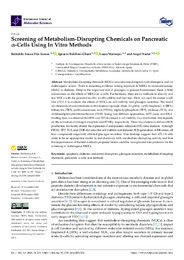Please use this identifier to cite or link to this item:
https://hdl.handle.net/11000/38005Full metadata record
| DC Field | Value | Language |
|---|---|---|
| dc.contributor.author | dos Santos, Reinaldo Sousa | - |
| dc.contributor.author | Babiloni-Chust, Ignacio | - |
| dc.contributor.author | Marroquí, Laura | - |
| dc.contributor.author | Nadal, Ángel | - |
| dc.contributor.other | Departamentos de la UMH::Fisiología | es_ES |
| dc.date.accessioned | 2025-11-10T11:19:11Z | - |
| dc.date.available | 2025-11-10T11:19:11Z | - |
| dc.date.created | 2022-12 | - |
| dc.identifier.citation | International Journal of Molecular Science, Vol. 24, Nº 1 (2023) | es_ES |
| dc.identifier.issn | 1422-0067 | - |
| dc.identifier.uri | https://hdl.handle.net/11000/38005 | - |
| dc.description.abstract | Metabolism-disrupting chemicals (MDCs) are endocrine disruptors with obesogenic and/or diabetogenic action. There is mounting evidence linking exposure to MDCs to increased susceptibility to diabetes. Despite the important role of glucagon in glucose homeostasis, there is little information on the effects of MDCs on -cells. Furthermore, there are no methods to identify and test MDCs with the potential to alter -cell viability and function. Here, we used the mouse -cell line TC1-9 to evaluate the effects of MDCs on cell viability and glucagon secretion. We tested six chemicals at concentrations within human exposure (from 0.1 pM to 1 M): bisphenol-A (BPA), tributyltin (TBT), perfluorooctanoic acid (PFOA), triphenylphosphate (TPP), triclosan (TCS), and dichlorodiphenyldichloroethylene (DDE). Using two different approaches, MTT assay and DNAbinding dyes, we observed that BPA and TBT decreased -cell viability via a mechanism that depends on the activation of estrogen receptors and PPAR , respectively. These two chemicals induced ROS production, but barely altered the expression of endoplasmic reticulum (ER) stress markers. Although PFOA, TPP, TCS, and DDE did not alter cell viability nor induced ROS generation or ER stress, all four compounds negatively affected glucagon secretion. Our findings suggest that TC1-9 cells seem to be an appropriate model to test chemicals with metabolism-disrupting activity and that the improvement of the test methods proposed herein could be incorporated into protocols for the screening of diabetogenic MDCs. | es_ES |
| dc.format | application/pdf | es_ES |
| dc.language.iso | eng | es_ES |
| dc.publisher | MDPI | es_ES |
| dc.rights | info:eu-repo/semantics/openAccess | es_ES |
| dc.rights | Attribution-NonCommercial-NoDerivatives 4.0 Internacional | * |
| dc.rights.uri | http://creativecommons.org/licenses/by-nc-nd/4.0/ | * |
| dc.subject | Apoptosis | es_ES |
| dc.subject | Diabetes | es_ES |
| dc.subject | Endocrine disruptors | es_ES |
| dc.subject | Glucagon secretion | es_ES |
| dc.subject | Metabolism disrupting chemicals | es_ES |
| dc.subject | Pancreatic alpha-cells | es_ES |
| dc.subject | Test methods | es_ES |
| dc.title | Screening of Metabolism-Disrupting Chemicals on Pancreatic alpha-Cells Using In Vitro Methods | es_ES |
| dc.type | info:eu-repo/semantics/article | es_ES |
| dc.relation.publisherversion | https://doi.org/10.3390/ijms24010231 | es_ES |

View/Open:
Screening of metabolism-disrupting....pdf
3,22 MB
Adobe PDF
Share:
.png)
